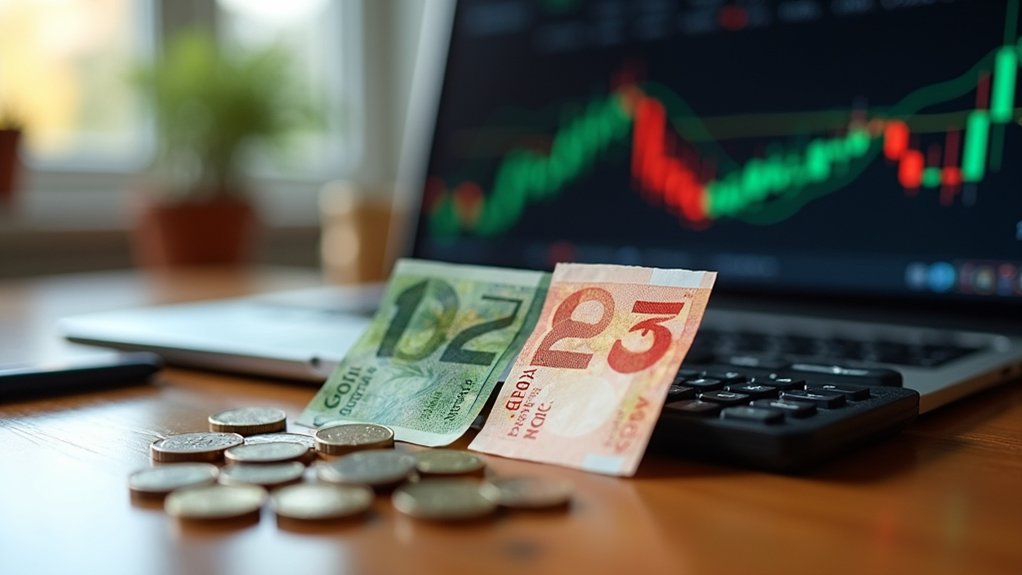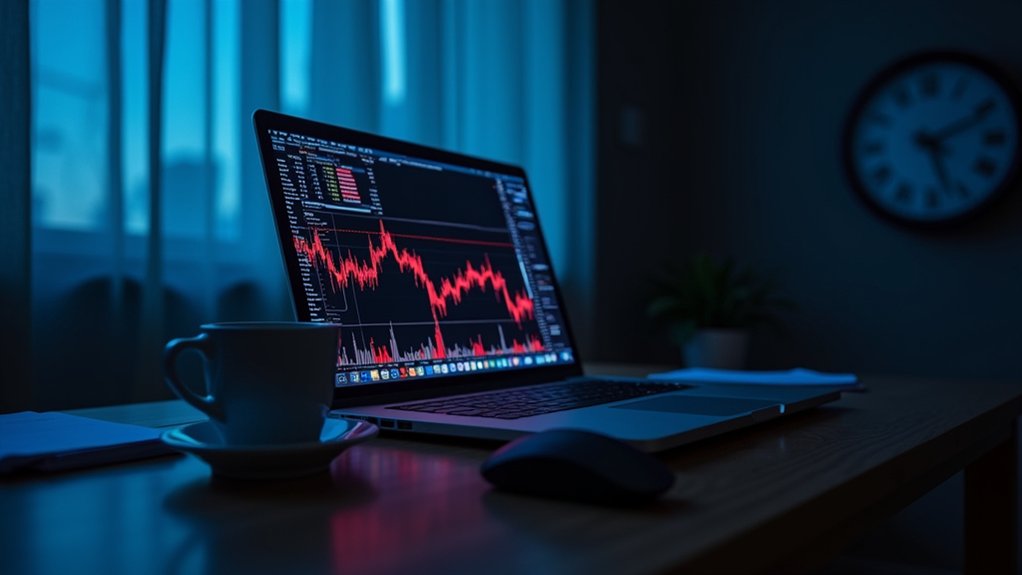A forex quote shows two currencies—base first, quote second—with a number revealing how much of the quote currency buys one unit of the base. EUR/USD = 1.2563 means one euro costs 1.2563 dollars. Every quote displays a bid price for selling and an ask price for buying, with the spread between them lining the broker's pockets. Major pairs like EUR/USD offer tight spreads, while exotics involving emerging market currencies deliver wider gaps and wilder rides. The mechanics below reveal the rest.

Currency pairs sit at the heart of every forex trade, and for traders across Nigeria, Kenya, South Africa, and the rest of the continent, understanding how to read them isn't optional—it's survival.
A forex quote always appears as two currencies paired together. The first one listed is the base currency. The second is the quote currency. Simple enough. EUR/USD = 1.2563 means one euro equals 1.2563 US dollars. The base currency is what's being valued. The quote currency is what you need to buy one unit of the base.
Most pairs use three-letter ISO codes. EUR for euro, USD for US dollar, ZAR for South African rand, NGN for Nigerian naira. The structure never changes. The quote always shows how much of the quote currency buys one unit of the base currency. Always. The exchange rate determines the precise amount of quote currency required to purchase a single unit of the base currency. The quote currency represents the value against which the base currency is measured in every forex pair.
Currency pairs fall into three categories. Major pairs always include the US dollar and offer the most liquidity. Think EUR/USD or GBP/USD. Minor pairs involve major currencies but skip the dollar entirely—EUR/GBP, for example. Cross-currency quotes are direct quotes between two non-USD currencies that bypass dollar conversions entirely. Exotic pairs combine one major currency with one from a developing nation. These deliver higher volatility and fatter spreads. African traders often encounter exotics when trading their local currencies against majors.
Every quote has two prices: bid and ask. The bid price is what you get when selling the base currency. The ask price, sometimes called the offer, is what you pay when buying. The difference between them is the spread. That spread is the broker's cut. Quotes typically appear as bid/ask—EUR/USD 1.3849/1.3851. Spreads widen when liquidity drops or volatility spikes. Exotics bleed spreads. Majors keep them tight. Market makers adjust their bid-offer spread to attract buyers or sellers depending on their current exposure and inventory needs. These two-sided quotes reflect the market's willingness to both buy and sell at different prices simultaneously.
Naming conventions follow patterns. American convention puts USD as the quote currency. European convention flips it, making USD the base. The Swiss franc commonly appears in European terms as USD/CHF in the spot market. Exceptions exist. For GBP, EUR, AUD, and NZD, the dollar gets quoted second regardless.
Reading exchange rates correctly determines whether a trader enters or exits at the right moment. When EUR/USD climbs from 1.2000 to 1.2500, the euro strengthened against the dollar. The base currency gained value. Rates fluctuate constantly thanks to supply, demand, and economic noise. Understanding support and resistance levels helps traders identify where buying interest attracts capital or selling pressure dominates price action. Forex trades are typically conducted in lots of 100,000 units of the base currency, which standardizes position sizing across the market. The foreign exchange market operates 24 hours a day across global financial centers, allowing continuous price discovery and trade execution.
Practical examples clarify the structure. USD/JPY = 110.25 means one US dollar equals 110.25 Japanese yen. GBP/USD = 1.4100 means one British pound equals 1.4100 US dollars. The amount being bought or sold always refers to the base currency. Get that wrong and calculations crumble. Leverage magnifies every quoted movement, turning small shifts into significant gains or devastating losses.
Common Questions
How Do Nigerian Naira or Kenyan Shilling Quotes Differ From Major Pairs?
Nigerian Naira and Kenyan Shilling quotes move differently than EUR/USD or GBP/USD. Liquidity? Much thinner. Spreads? Wider. Volatility? Higher, because local economic factors hit harder—oil prices shake the Naira, tea exports nudge the Shilling.
Nigeria's dual-rate system complicates things further. Official versus black market rates create confusion. Major pairs attract institutional money and tighter regulation.
NGN and KES quotes respond more dramatically to central bank announcements, political instability, and regional events. Less predictable, more prone to sudden swings.
Which African Brokers Offer the Most Competitive Spreads on Local Currencies?
AvaTrade (Official Site 🔗) and Exness lead the pack for African traders chasing tight spreads on local currencies. AvaTrade‘s FSCA regulation in South Africa gives it credibility, while Exness explicitly mentions competitive spreads on “many currency pairs,” hinting at local options.
The rest? Pepperstone, Fusion Markets, and BlackBull focus on majors—EUR/USD, GBP/USD—leaving naira, shilling, and kwanza traders hunting for scraps. Most brokers stay vague about African currency specifics. Frustrating, but typical.
Do African Forex Platforms Show Quotes in Real-Time or Delayed Rates?
Most regulated African forex platforms—think FSCA-licensed brokers in South Africa or CMA-approved outfits in Kenya—deliver real-time quotes.
It's standard now. IG, MetaTrader apps, and top-tier local platforms push live data to stay competitive and compliant.
Demo accounts? Sometimes delayed. Shady, unregulated platforms? Maybe stale pricing.
But serious brokers can't afford lagging quotes—traders would bolt. Check the fine print: legit platforms state “real-time” upfront.
Weekend rates freeze because markets close, not broker trickery.
How Does Currency Control in Zimbabwe Affect Forex Quote Availability?
Currency controls in Zimbabwe choke forex quote availability badly.
The official rate sits at 26.4 ZIG per USD as of February 2025, but that's mostly fiction.
Real quotes? Hard to find.
Exchange restrictions force exporters to convert proceeds through authorized dealers, limiting transparent price discovery.
The Reserve Bank intervenes constantly to manage volatility, not reflect true market prices.
Meanwhile, 80% of the economy operates informally in USD anyway.
ZIG quotes exist on paper, reality's elsewhere.
Can I Trade African Currency Pairs Outside South Africa and Egypt Legally?
Yes, trading African currency pairs outside South Africa and Egypt is legal—if local laws permit forex trading and the broker holds proper licenses.
No global ban exists.
ZAR pairs are widely available.
NGN, KES, EGP? Much harder to find.
Most international brokers require regulatory approval (EU, UAE, UK) and enforce strict AML and KYC rules.
Capital controls from African central banks can limit access for residents, but international traders typically aren't blocked.
Use only licensed brokers.










